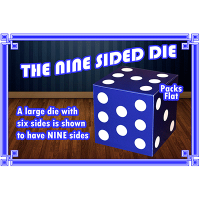Nine Sided Die
Carbone, Angelo
(Based on 1 review)

Based on a classic of magic but now brought up to date and applied to three dimensions, the Nine Sided Die is a fun, puzzling piece of magic. The best part, it folds completely flat and can be slipped into your performance case with ease.
Suitable for all ages.
Dimensions: 4.25" (11cm) as a cube. 8.5 x 5.5" (14 x 22cm) folded flat.
Reviews
(Top ▲)
The trick now known as the Surprising Dots (and by other names in the past) is a classic of magic, especially for children's shows. The front and back of a large domino are shown several times, and the number of dots keeps changing. The magician gives a fake explanation of how the trick is done, and then goes on to change the number of dots in a magical way that obviously has nothing to do with the fake explanation.
The Nine Sided Die is like a three-dimensional version of the Surprising Dots. Specifically, the magician holds up a blue die with white spots and begins rotating it while counting aloud. showing a side with one dot, a side with two dots, and so on, up to six dots. The big surprise comes when the magician, after showing the side with six dots, goes on to show a side with seven dots, a side with eight dots, and (if desired) a side with nine dots, thus demonstrating in a very clean manner that the die has eight (or nine) sides.
I really enjoy this trick. It's a fooler, has some inherent humor, and is fairly easy to learn. However, I'm giving it only three stars for the following reasons: (1) Whereas the Surprising Dots is an entire 2-3 minute routine with humor, drama and surprise, the Nine Sided Die is just a quickie demonstration, lasting perhaps 20-seconds. I like the effect, but it's over very swiftly, and I haven't figured out a way to build it up or give it more drama. (2) The die is made from cardboard. The cardboard is high quality with an attractive color -- but it won't stand up to constant usage or being dropped more than a few times. I really would have preferred for the cube to be made of something more durable -- for instance, lightweight painted metal, somewhat like the enameled boxes that dominoes are sometimes sold in (or the game Mexican Train). (3) The die is not very practical for walk-around, which is my main interest. I suppose it could be put into a cloth bag -- but it's much too big for a pocket and would have to be set on a floor or put into a case when not in use. The angles aren't great -- spectators will see too much if they are standing to the side of the magician. The trick could be included in a parlor-type show, for instance for a small party. But in its current state of development, it would provide only about 30 seconds of entertainment. And it's not clear whether the trick will work with children -- in order to appreciate the trick, a child must be familiar with dice and have a firm grasp of the fact that a die has exactly six sides. I plan to try the trick with various age groups to see how they react.
The Nine Sided Die is like a three-dimensional version of the Surprising Dots. Specifically, the magician holds up a blue die with white spots and begins rotating it while counting aloud. showing a side with one dot, a side with two dots, and so on, up to six dots. The big surprise comes when the magician, after showing the side with six dots, goes on to show a side with seven dots, a side with eight dots, and (if desired) a side with nine dots, thus demonstrating in a very clean manner that the die has eight (or nine) sides.
I really enjoy this trick. It's a fooler, has some inherent humor, and is fairly easy to learn. However, I'm giving it only three stars for the following reasons: (1) Whereas the Surprising Dots is an entire 2-3 minute routine with humor, drama and surprise, the Nine Sided Die is just a quickie demonstration, lasting perhaps 20-seconds. I like the effect, but it's over very swiftly, and I haven't figured out a way to build it up or give it more drama. (2) The die is made from cardboard. The cardboard is high quality with an attractive color -- but it won't stand up to constant usage or being dropped more than a few times. I really would have preferred for the cube to be made of something more durable -- for instance, lightweight painted metal, somewhat like the enameled boxes that dominoes are sometimes sold in (or the game Mexican Train). (3) The die is not very practical for walk-around, which is my main interest. I suppose it could be put into a cloth bag -- but it's much too big for a pocket and would have to be set on a floor or put into a case when not in use. The angles aren't great -- spectators will see too much if they are standing to the side of the magician. The trick could be included in a parlor-type show, for instance for a small party. But in its current state of development, it would provide only about 30 seconds of entertainment. And it's not clear whether the trick will work with children -- in order to appreciate the trick, a child must be familiar with dice and have a firm grasp of the fact that a die has exactly six sides. I plan to try the trick with various age groups to see how they react.







